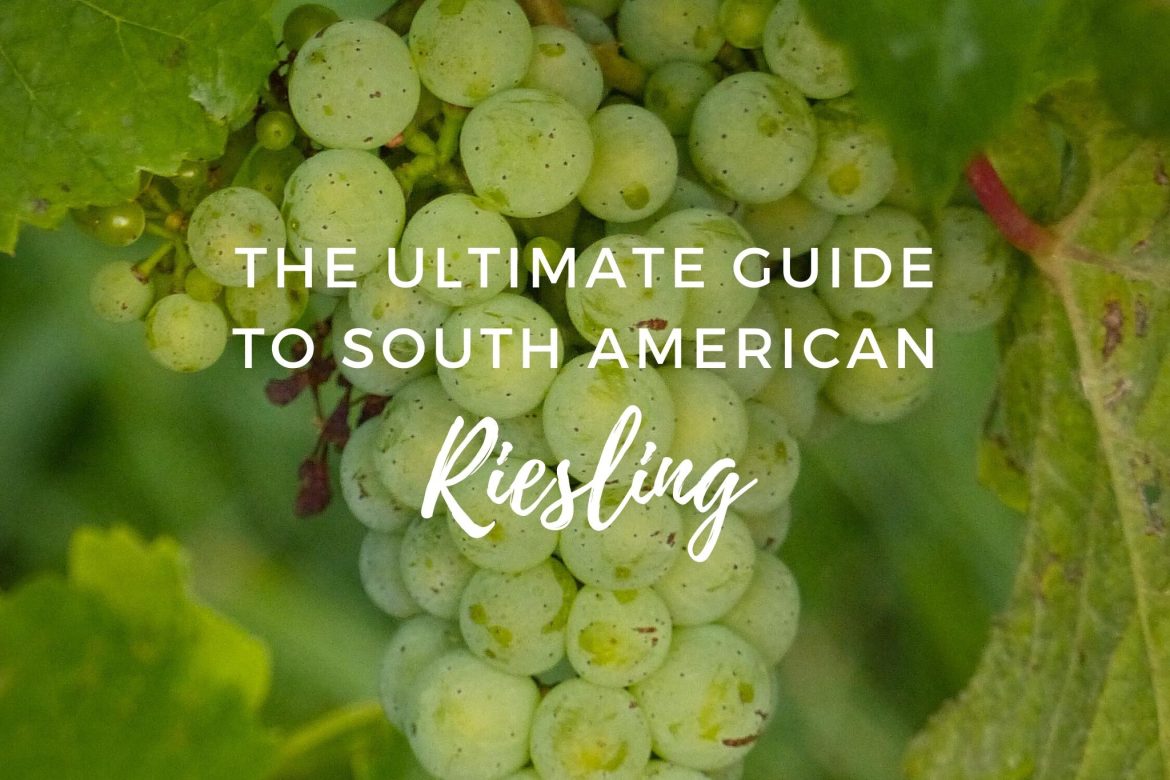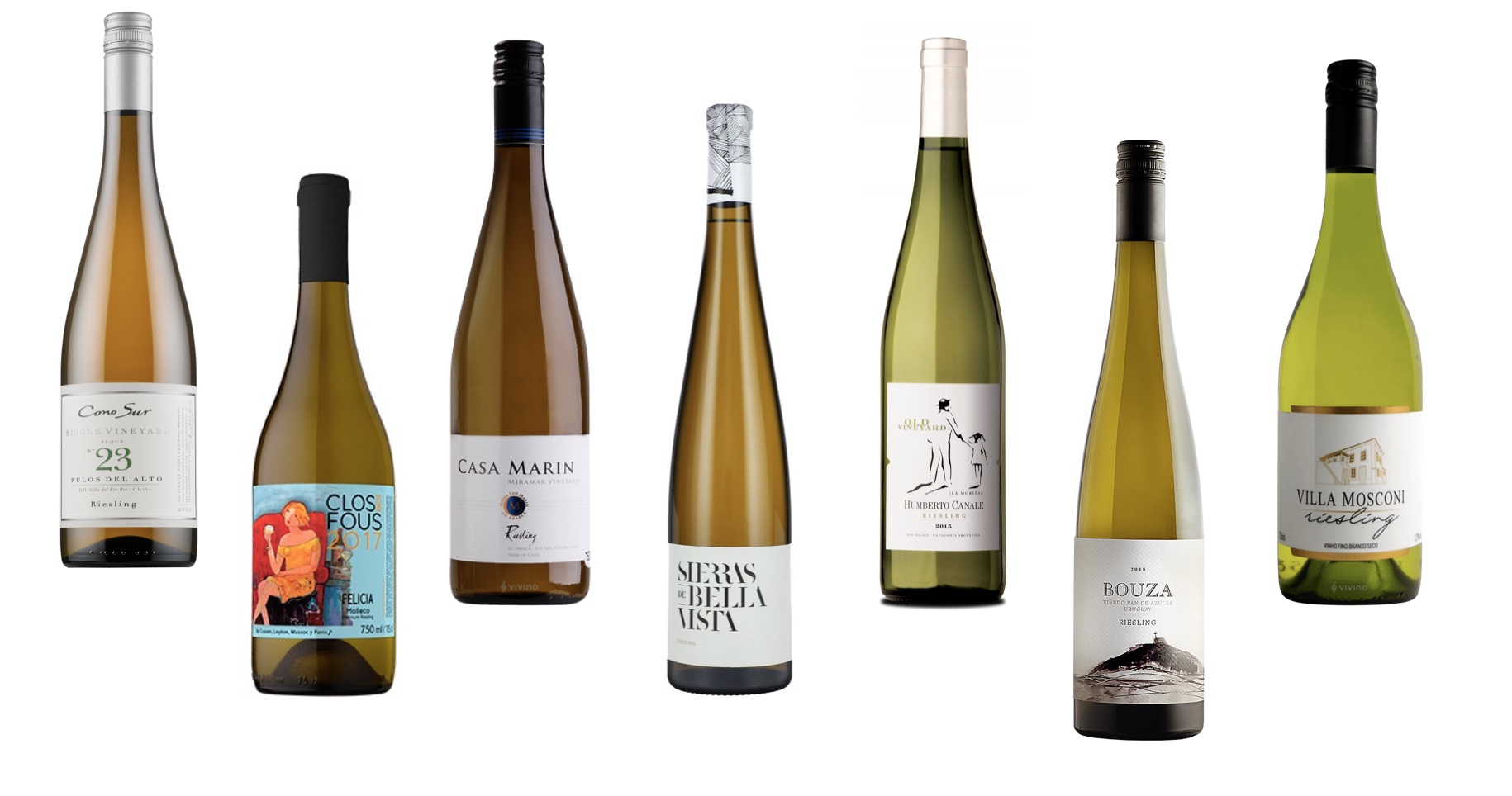In our guide to Riesling in South America we look at the best wines in Chile, Argentina, Uruguay and Brazil, as well as offering an insight into Riesling plantings and the best wine regions for this complex white grape variety. Riesling was first planted in South America back in the late-19th century and, although it is still niche, it has grown in popularity since, both as a single varietal and in old vine field blends. As we get ready to celebrate Riesling Day on 13th March, we thought it was high time to raise a glass to South American Riesling!
Ultimate Guide to Riesling in South America
Riesling key descriptors
Pale lemon colour. Aromas of white blossom, citrus zest & petrol. Dry with searing (high) acidity and medium body.
Riesling winemaking styles
South American Riesling is usually vinified in stainless steel with little or no skin contact, and unoaked or aged in old, neutral oak barrels. It is usually monovarietal and alcohol is normally 13% – 13.5%. Although there are some interesting old vine field blends being made (sometimes with skin contact as orange wines) and it is also being deployed in the new wave of white wine blends.
Riesling in Chile
Hectares planted: 394 hectares
Riesling was supposedly first brought to Chile by Isadora Cousiño in the 19th century and, as a result, there are many old Riesling vines hidden in field blends in the traditional valley floor wine regions. Many of these locations are today too hot to make great wines, but the old vines in Itata seem to prove the exception to the rule. However, it’s the new Riesling vines I’m most excited about, as winemakers are taking this fickle variety to new terrains where it can really come into its own.
There are some excellent coastal Riesling wines coming from San Antonio, and Leyda and Lo Abarca in particular, which have a zesty character. Another exciting new terrain for Riesling is in Chile’s southern region of Bio Bio, Malleco and Osorno where cooler temperatures produce a more mineral Riesling with searing acidity. One of my favourite Chilean Rieslings is in fact a mountain Riesling — so far the only one — from high altitude Colchagua: the racy, austere Riesling of Sierras de Bellavista.
Riesling may be a historic variety for Chile, but it’s being given a new lease of life as winemakers take it to new cool-climate frontiers.
Favourite producers
Sierras de Bellavista, Leyda, Casa Marín, Cono Sur, Matetic, Clos de Fous, Casa Silva Lago Ranco, Fatto a Mano, Rogue Vine
Riesling in Argentina
Hectares planted: 74 hectares
There’s not much Riesling in Argentina as most of the traditional wine regions are simply a bit hot for good quality Riesling. There are some good wines from old vines to be found though, mainly in Río Negro in southern Argentina, and a couple interesting wines coming from Mendoza.
But a new movement of Riesling is more likely to come from new cool climate wine regions of Chubut in Patagonia, and the coastal wine region of Buenos Aires. There’s potential, but it’s still rather unexplored.
Favourite producers
Humberto Canale, Costa y Pampa, Luigi Bosca, Viña Las Perdices, Doña Paula, Nant y Fall
Riesling in Brazil
Hectares planted: 292 hectares
Brazil on the surface appears to have quite a lot of Riesling. But Although known locally as Italian Riesling, this is actually Welschriesling and it was first brought to Brazil over 100 years ago. Because of its rather neutral aromas and high acidity, it is often used as a base for sparkling wine. However, some producers do make it into a light-bodied, crisp white wine, which can be particularly successful when grown at high altitudes.
Favourite producers
Villa Mosconi
Riesling in Uruguay
Hectares planted: <10 hectares
There’s not much Riesling planted in Uruguay but there is one Riesling I’m particularly excited about: Bouza’s Pan de Azucar Riesling in Maldonado! It offers a glimpse at the potential for Riesling in this coastal region — zippy, mineral and fragrant.
Favourite producers
Terroir Selection: Best Riesling wines to try from South America
 CONO SUR, Single Vineyard Block 23 Riesling
CONO SUR, Single Vineyard Block 23 Riesling
Mulchén DO. $. Drinking window <10 years
This is one of Chile’s best-kept secrets in top-value wine. The nose immediately takes you to Riesling: that waft of petrol with a flinty, citrus zest and white blossom undertone. Chile’s answer to the Mosel!
CLOS DES FOUS, Felicia
Traiguén. $$. Drinking window <20 years
I love this lean style of oaked Riesling with its electric acidity and fresh notes of green apple with those oh- so-desirable petrol notes. Thrilling to drink.
Click to see Felicia’s tasting note
CASA MARIN, Miramar Riesling
Lo Abarca. $. Drinking window <10 years
Riesling isn’t widely grown in Chile but there are some convincing coastal Riesling wines and for me Casa Marín pulls it off best: the paraffin notes so typical of Riesling, along with lime zest and mineral aromas and a spritzy, saline and long finish. Their Sauvignon Gris is another delicious oddity to try.
SIERRAS DE BELLAVISTA, Riesling
Sierras de Bellavista. $$. Drinking window <15 years
At 1,100 m.a.s.l., this is a seriously high-altitude vineyard by Colchagua’s standards and it shows a completely different side of this appellation: one that is ideal for steely, cool-climate white wines! Notes of citrus flowers, lemon zest and wet stones dance over this taut, elegant Riesling.
LUIGI BOSCA, Riesling
Las Compuertas GI. $. Drinking window <10 years
This Riesling made with grapes from 60-year-old vines showcases the white wine potential of this cool sub- region. This lightbodied, spritzy style of Riesling with notes of green apples, white peaches and chamomile is an anomaly in Argentina.
HUMBERTO CANALE, Old Vineyard Riesling
Rio Negro. $. Drinking window <10 years
Humberto Canale has excellent old-vine Semillon and Pinot Noir, but this Riesling is one of Argentina’s best. 83-year-old vines produce a wine of intensity and length, with white peach and citrus aromas. A steal at US$20.
BOUZA, Riesling Viñedo Pan de Azúcar
Pan de Azúcar. $$. Drinking window <20 years
The Bouza family’s new vineyards in Maldonado are incredibly exciting and this Riesling already shows the great potential for racy white wines here. White blossom, lime zest and waxy notes with a saline minerality, this is one of the best Rieslings in Latin America.
VILLA MOSCONI, Riesling
Andradas. $. Drinking window <5 years
Riesling Itálico is much simpler in expression than Riesling, but can be just as enjoyable, as this top-value wine from Villa Mosconi proves. Lightly scented with aromas of lemon sherbet, green apple and white blossom, it’s a delicate and crisp wine, and just 11.5% abv.

